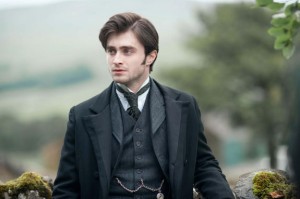

Daniel Radcliffe may not be wearing circular glasses or Gryffindor robes in “The Woman in Black,” but it’s hard to see the actor as anyone but Harry Potter. Shots of trains rumbling along the English countryside and of Radcliffe (playing the widowed solicitor Arthur Kipps) wandering through dark corridors in the middle of the night practically beg theater-goers to yell “Lumos!” and the like.
But Kipps doesn’t have Potter’s power — neither the magic, nor the strength of will. Kipps is a lawyer who is about to lose his job. He is in a seemingly eternal state of mourning since the death of his wife during childbirth. He is alone and vulnerable and Director James Watkins doesn’t let you forget it. Kipps is the ideal lead for a horror film that doesn’t break any new ground, but instead does old-school scary justice on screen for the first time in too long.
Based on a 1983 novel by Susan Hill, “The Woman in Black” covers all of the period-style fright film bases. A protagonist with a tortured past? Got it. A haunted house secluded from society? It’s there. Psychotic breaks? They happened. Dead kids? Everywhere. British accents? All over this.
But it’s the things lurking in the corners — and those that are mysteriously missing — in each scene that keep tension high. Like the toys — those dirty, cracked, circus-inspired dolls whose demonic dead-eyes seem more emotive than some of Radcliffe’s supporting cast. They have just enough upturned smiles, though, to make the figurines in “The Woman in Black” seem
different.
The story’s villain — the ghost of a psychotic woman whose son was taken from her by her own sister before he sank and died in the muck of a monstrous marsh —— is also not overly original. Her scariness lies in her mystery. She only appears through the cracks of the doors of the house that Kipps is appraising (or something of that nature)…and when she reenacts her own suicide.
The character and the way she was handled was married to the “less is more” cliché, but there is nothing wrong with that.
The storyline is mostly forgettable, and conversations were kept to a minimum. But it was the silent scenes are the ones that shined through all of the blacks, grays and deep, earthy browns of “The Woman in Black.”
This is a movie about images, and it’s hard to call a 10-year-old girl lighting herself on fire anything but terrifying.
3 stars
